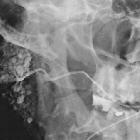Treacher Collins syndrome








Treacher Collins syndrome, also known as mandibulofacial dysostosis, is an autosomal dominant genetic abnormality and results from bilateral malformations of first and second branchial arches (see branchial apparatus).
Epidemiology
The incidence is estimated at approximately 1 in 50,000 live births, with 60% of cases being sporadic, and 40% having a family history of the condition .
Clinical presentation
Patients have dysmorphic structures derived from the first and second pharyngeal pouch, groove, and arch. Conductive hearing defects are present.
Pathology
The majority of cases (80-90%) are due to mutations of the TCOF1 gene, located on chromosome 5, which encodes a nucleolar phosphoprotein “Treacle” . Two other genes also are known to cause Treacher Collins syndrome: POLR1C and POLR1D .
Radiographic features
- dental and mandibular
- retrognathia
- micrognathia
- macrostomia
- hypoplasia or aplasia of the condylar and coronoid processes of the mandible
- marked bowing of the lower border of the mandible
- concave curvature of the horizontal ramus of the mandible is pathognomonic
- may be associated with cleft palate and absence of parotid glands
- zygomatic arch: malformed, underdeveloped or absent
- otic
- microtia and aplasia of the external auditory meatus
- hypoplasia of the middle ear cavity
- hypoplasia or aplasia of the middle ear ossicles
- nasal
- obliteration of the nasofrontal angle with narrow nares
- hypoplasia of the alar cartilages
- hypoplastic paranasal sinuses
- ocular
- downward slanting palpebral fissures, due to lack of support from zygoma
- absent eyelids of the lower inner third of the eye
- notched iris
- notched choroid and colobomas
History and etymology
Treacher Collins syndrome was named after Edward Treacher Collins (1862-1932), an English ophthalmologist and surgeon who published two cases in 1900, describing many of the features . The condition is believed, however, to have been described first by Thompson in 1846 . In 1949 Franceschetti and Klein published the first comprehensive review of the topic and introduced the term mandibulofacial dysostosis .
Siehe auch:
- Glandula parotidea
- Mikrognathie
- Kolobom
- Mandibula
- Ohrmuschelfehlbildung
- hypoplastischer Jochbogen
- abnormal middle and external ears
und weiter:
- Minderbelüftung der Mastoidzellen
- mandibuläre Retrognathie
- Mikrophthalmus
- microtia
- Gehörgangsatresie
- Mandibulo-faziale Dysostose-Mikrozephalie-Syndrom
- classification of paediatric midface anomalies
- acrofacial dyostosis
- craniofacial syndromes in children
- Makrostomie
- Aplasie der Glandula parotis
- Aplasie des Jochbogens

 Assoziationen und Differentialdiagnosen zu Franceschetti-Zwahlen-Syndrom:
Assoziationen und Differentialdiagnosen zu Franceschetti-Zwahlen-Syndrom:





